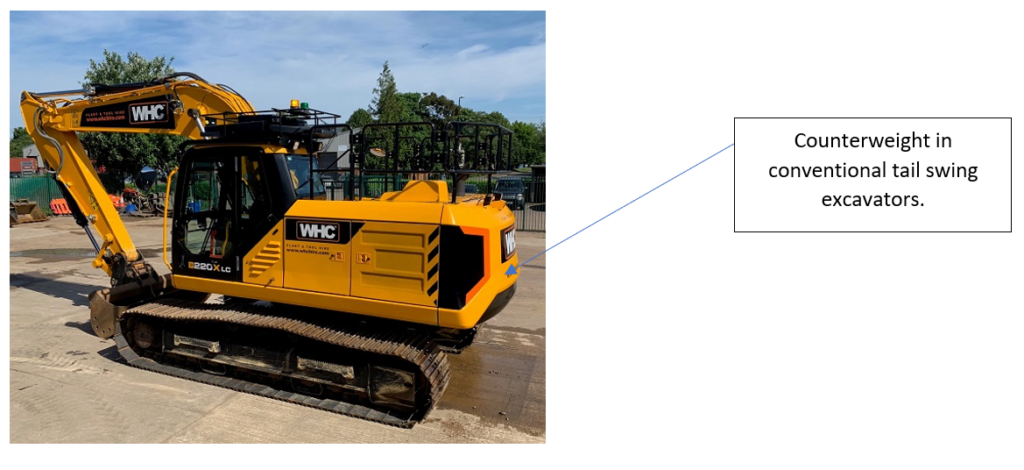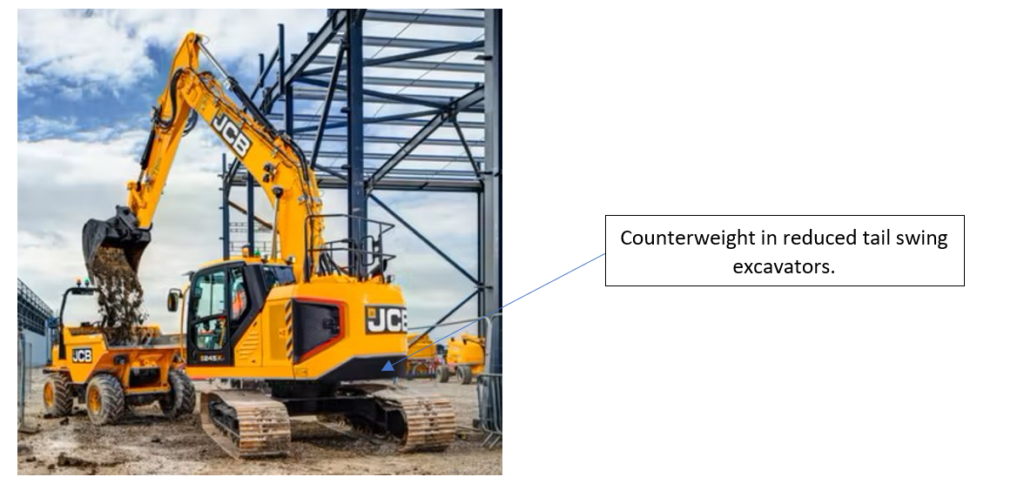Reduced or conventional tail swing in excavators? How to choose.
If you have never heard of a reduced or conventional tail swing excavator, then understanding the difference between the two will benefit you when choosing to hire one. As you delve deeper into investigating more about the types of excavators, then the question of tail swing will no doubt come up.
But by applying this knowledge to your site assessment, you will be able to make the best financial and positive decision to benefit the productivity of your project. In this article, we will help you understand more about tail swing in large excavators, why it becomes a big factor, and what the benefits are of choosing specific machines.
What is a conventional tail swing excavator?
Conventional tail swing excavators have a rear counterweight profile that extends over the steal tracks when rotated. The counterweight plays an essential role in allowing the machine to balance. It keeps the centre of gravity of an excavator close to the centre of rotation, allowing operators to load and unload safely without tipping the equipment. Excavators already benefit from a low centre of gravity, however, machines that have large lifting capacities require larger counterweights.
Additional counterweights have to be fitted to an excavator if the arm length or load capacity is to increase. It is for this reason that larger counterweights are found on specialised long-armed excavators. No matter the size of the excavator that you would potentially use, it will have some type of counterweight incorporated into it.
In this photo, you will be able to see the counterweight at the rear of the machine.

What is a reduced tail swing excavator?
Reduced or zero tail swing excavators are different to conventional style machines, as their bodies rotate within their tracks. Reduced tail swing machines are designed so that the counterweight balances underneath the rear of the excavator to maximise distance away from its pivot. As there is less room for the counterweight to be housed, it has a direct impact on the total load capacity of the machine.
In this photo, you will be able to see the counterweight at the bottom of the rear of the machine.

Benefits of conventional Vs reduced tail swing excavator?
A conventional excavator will usually achieve the maximum digging performance among all the different types on the market. A larger tail swing equals more leverage, in effect resulting in a larger output and capacity. These types of excavators are ideal for long reach requirements or in wide-open spaces where there are no or little amounts of obstacles. Conventional excavators are also popular as cranes to lift large weights if necessary.
Cons of conventional excavator vs reduced tail swing?
A conventional excavator is ideal for the removal of large amounts of bulk debris or materials in an area that does not have any obstacles. However, due to their sheer size and tail swing, they are not as practical in built-up areas or working close to buildings. Using a conventional excavator in these situations could cause unnecessary damage or injury.
Benefits of reduced tail swing excavators
Reduced tail swing excavators are very beneficial when working in tighter spaces. Unlike conventional excavators, their counterweight only exceeds the chassis of the machine by only a few centimetres. This makes for a machine that is highly manoeuvrable in built-up areas, as well as one that offers a larger lifting capacity than a zero-tail swing machine.
Cons of reduced tail swing excavators
When choosing an excavator, the small differences can all add up, especially with efficiency. Over long periods of use reduced tail swing excavators are less efficient than conventional. This is because a conventional excavator can handle larger, faster loads than a reduced tail swing model. However, your decision to choose either machine should be down to the amount of access and space you have available.
One other small disadvantage to using a reduced or zero tail swing excavator is the ability to access and maintain them if something is to go wrong. As you can imagine, manufacturers have had to try and pack what space they have available with all the machines functioning components. This, in turn, can make maintaining some models far more difficult than a conventional excavator.
Attachment versatility
You may think that conventional excavators are far more versatile than reduced tail swing excavators. However, despite their difference in size and lifting capabilities, reduced tail swing excavators do offer a huge amount of versatility, just as a conventional machine would do. When paired with the correct attachment a reduced tail swing excavator can be very efficient.
Popular attachments for a reduced tail sing excavator are:
- Hydraulic quick hitch
- Hydraulic breaker
- Land rake
- Hydraulic post knocker
- Hydraulic wacker plate
Consider these points before hiring an excavator.
Understanding the specific requirements of your excavator is important to ensure that you hire the correct machine. Tail swing of both a reduced and conventional excavator can be found in a machine’s specifications, but if you are unsure then always consult a professional to help.
Some key information you will want to know is:
- Arm breakout force
- Engine horsepower
- Hydraulic flow
- Lifting capacity
- Maximum digging depth
- Maximum loading height
- Maximum reach, ground level
- Operating weight
You can find out how to hire the right excavator for the job here.
Which is more expensive to hire?
Hiring a conventional or reduced tail swing excavator is a cost-effective way of speeding up your project. But what about the price? Prices of machinery can fluctuate between suppliers, as well as how they classify their machinery.
Reduced or zero tail swing excavators can be classed as specialised equipment, which can increase the cost of a weekly hire rate (Company dependant). But this is not always the case. Companies that operate with newer machinery regularly, will have very competitive prices for their reduced and zero tail swing machines. Why? Because manufacturers constantly change the way they design and build excavators.
In conclusion, specialised excavators, like reduced tail swing machines, are generally slightly more expensive to hire than conventional. However, depending on the hire company you work with could determine the difference.
Need help hiring a conventional or reduced tail swing excavator?
Our team at WHC Hire have been supplying excavators to businesses, contractors and the general public for over 20 years. Equipped with some of the latest stage v emissions technology on the market, our fleet consists of some of the finest available. With constant reinvestment into the quality of our fleet, we can ensure all our customers/clients that our machinery is delivered in perfect working condition. With an extensive fleet ranging from micro to 30T excavators, we are sure to have the right machine to help you get the job done. Discuss your requirements with one of our hire professionals today on 01684377977. Alternatively, click here to see to discover our full plant equipment range.

